Content marketing stands at the crossroads of creativity and strategy, offering businesses and individuals an opportunity to engage, inform, and inspire their target audience meaningfully and authentically. At its core, content marketing isn’t just about selling products or services but about sharing valuable information that builds trust, fosters relationships, and positions the brand as a thought leader in its niche. Whether you’re a budding entrepreneur, a seasoned marketer looking to refresh your approach, or simply curious about the digital landscape, this beginner’s guide will walk you through the fundamental principles, strategies, and tools of content marketing.
What Is Content Marketing?
Content marketing definition is a deliberate marketing strategy centered on producing, sharing, and disseminating meaningful, pertinent, and steady content. It aims to captivate and maintain a specific target audience, leading to beneficial customer behaviors. Rather than directly promoting your products or services, you’re offering genuinely valuable content to your potential clients and customers, assisting them in addressing their challenges. Many content marketing agencies offer content marketing services. There are many types of content marketing examples. You can choose one of these according to your strategy. A content marketer may help you with this issue.
Key Elements That Set Content Marketing Apart from Other Marketing Tactics
Several key elements set content marketing apart from other marketing tactics:
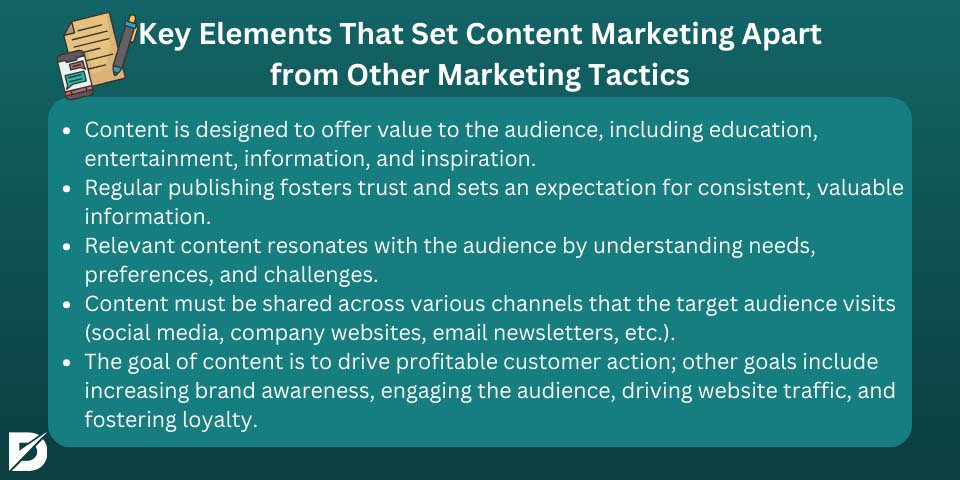
- Value Proposition: The content is designed to offer its audience value, not just promote a brand or product. This could be through education, entertainment, information, or inspiration.
- Consistency: Regular publishing keeps the audience engaged, and fosters trust. It sets the expectation that the brand is a consistent source of valuable information.
- Relevance: Understanding the audience’s needs, preferences, and challenges ensures that the content is relevant and resonates with them.
- Distribution: It’s not enough to create content; the content must be shared and distributed across various channels where the target audience spends their time, whether on social media, company websites, email newsletters, or other platforms.
- Goals: The ultimate goal might be to drive profitable customer action, but intermediary goals can include increasing brand awareness, engaging the audience, driving website traffic, and fostering loyalty.
Some common formats and types of content marketing include blogs, videos, infographics, podcasts, webinars, eBooks, whitepapers, case studies, and more. Content marketing can help businesses build trust, nurture leads, enhance brand loyalty, and establish themselves as authorities in their industry.
How to Do Content Marketing
The content marketing world is changing every day. Embarking on a content marketing journey requires a well-thought-out strategy and consistent execution. Here’s a step-by-step guide on how to do content marketing effectively. Let’s look at the important things in content marketing.
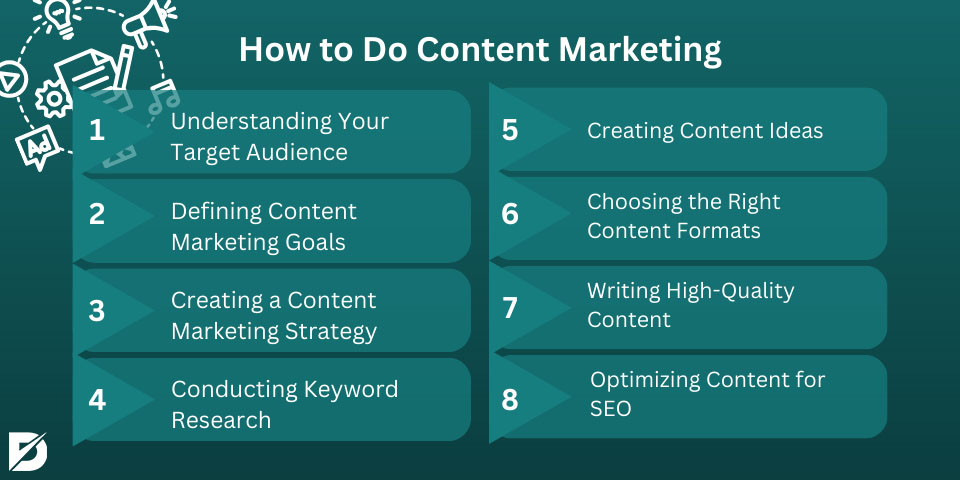
Understanding Your Target Audience
There are many ways to make a content marketing plan. This plan includes digital content marketing, video content marketing, and SEO content marketing. Here’s a detailed guide on how to understand your target audience:
- Define Demographics: Start with the basics. What is the age range, gender, education level, income bracket, marital status, and occupation of your typical customer?
- Psychographics Analysis: Dive into their lifestyle, habits, interests, values, and opinions. For example, are they eco-conscious? Do they value luxury or functionality?
- Behavioral Traits: How do they interact with products or services? This includes their buying habits, loyalty to brands, and product usage rate.
- Geographic Location: Where are they located? This isn’t just about country or city but can be as specific as neighborhoods, depending on your product or service.
- Pain Points and Needs: What problems or challenges do they face that your product or service can address?
- Create Buyer Personas: With the collected data, develop detailed profiles or “personas” for different segments of your audience. These should be so detailed that you can picture a day in their life.
- Survey and Feedback: If you have an existing customer base, conduct surveys or interviews. Direct feedback can provide insights that you might not have considered.
- Monitor Social Media: See what they’re talking about, what content they’re sharing, and who they’re following. Social listening tools can help you monitor mentions of your brand, competitors, or industry-related terms.
- Analyze Competitors: Look at your competitors’ audiences with a competitor analysis tool. What content are they targeting for their audience? This can provide both inspiration and gaps in the market.
- Website and Social Analytics: Tools like Google Analytics and Facebook Insights provide data on who is visiting your site or profile, their behavior, and other valuable metrics.
- Stay Updated: People’s needs, behaviors, and preferences change. Regularly revisit and update your audience profiles.
- Engage and Interact: Directly interacting with your audience can give invaluable insights. These interactions can deepen your understanding through comments, Q&A sessions, webinars, or face-to-face events.
- Test and Iterate: Regularly test your assumptions. For example, if you think a particular type of content resonates with a segment of your audience, experiment and see the results.
Defining Content Marketing Goals
Defining clear and actionable goals is critical in any content marketing strategy. You can create, measure, and refine your content efforts more effectively by understanding your goal. Here’s how to define your content marketing goals:
- Align with Business Objectives: Before you dive into content-specific goals, ask yourself what the broader objectives of your business are. Are you aiming for brand awareness, increased sales, or customer retention? Your content marketing goals should support these overarching business goals.
- SMART Goals: Make sure your content marketing goals are Specific, Measurable, Achievable, Relevant, and Time-bound. This framework helps ensure your goals are both clear and actionable.
- Types of Goals:
- Traffic Generation: Aim for a specific number of monthly visitors or a percentage growth in web traffic.
- Lead Generation: Define the number of leads you want to capture via content, such as newsletter sign-ups or downloads.
- Brand Awareness: Measure this through metrics like brand mentions, reach, and impressions.
- Engagement: Set goals for comments, shares, and average time spent on your content.
- Sales and Conversions: Aim for direct sales resulting from content or increasing conversion rates.
- Customer Retention and Loyalty: Track metrics like repeat visits, referral rates, or engagement with loyalty-focused content.
- Thought Leadership: This can be measured through invitations to industry events, publications citations, or organic search growth for brand-specific terms.
- Prioritize: While it’s tempting to aim for multiple goals simultaneously, it’s essential to prioritize them. Knowing your primary goal (e.g., lead generation over traffic) will influence content creation and distribution.
- Benchmark Against Competitors: Understanding where you stand with competitors can help set realistic and ambitious goals. For instance, if a competitor gains significant traction with video content, this might shape your objectives.
- Consider Your Audience’s Journey: Remember that different pieces of content will cater to different stages of the buyer’s journey (awareness, consideration, decision). Define goals for each stage.
- Decide on Key Performance Indicators (KPIs): For every goal, there should be specific KPIs that will measure its success. For example, if your goal is brand awareness, your KPI might be the number of shares or mentions.
- Document Your Goals: Write down your goals and ensure they’re easily accessible to your team. This will keep everyone aligned and focused.
- Review and Refine: Review your goals to ensure they align with your business objectives. As you gather data on your content’s performance, don’t be afraid to refine and adjust your goals.
- Stay Updated: As the digital landscape evolves, so should your goals. Stay updated with content marketing trends and adapt your objectives as necessary.
Remember, defining goals is just the beginning. The consistent measurement, analysis, and optimization of your content against these goals will ultimately determine your success in content marketing.
Creating a Content Marketing Strategy
Creating a content marketing strategy is a holistic process that involves understanding your audience, setting clear goals, and executing a plan to meet those goals through content. Here’s a step-by-step guide to help you craft an effective content marketing strategy:
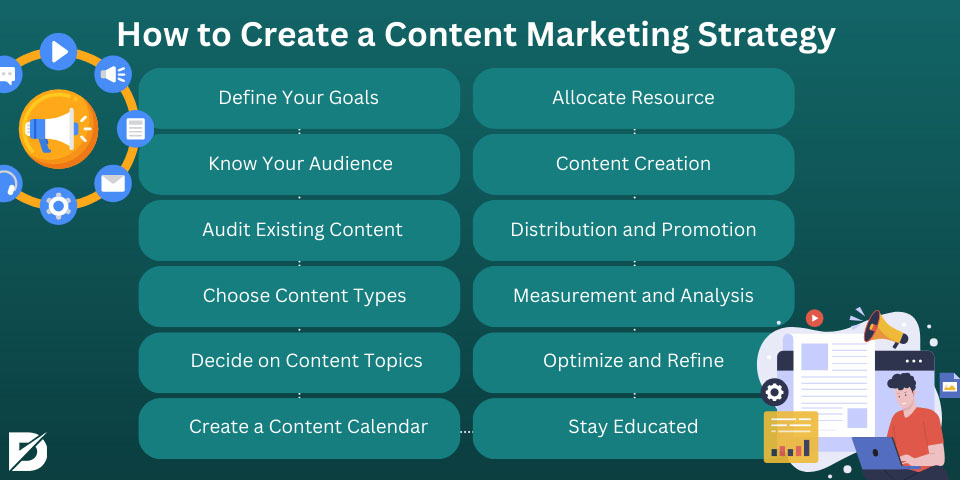
- Define Your Goals: As discussed earlier, you need to know what you’re aiming for. Are you looking to increase brand awareness, drive sales, foster loyalty, or something else? Your goals will guide every subsequent step.
- Know Your Audience:
- Research: Use tools, surveys, and existing data to understand your audience’s demographics, behavior, needs, and pain points.
- Create Buyer Personas: Develop detailed profiles for different segments of your audience.
- Audit Existing Content:
- Review what you’ve already created.
- Identify gaps, outdated content, and high-performing assets that can be optimized or repurposed.
- Choose Content Types:
- Based on your audience’s preferences and your resources, decide on formats like blogs, videos, infographics, podcasts, etc.
- Consider the buyer’s journey: Different content types may be more appropriate for different stages (awareness, consideration, decision).
- Decide on Content Topics:
- Keyword Research: Use tools like Google Keyword Planner or SEMrush to find what your audience is searching for.
- Competitive Analysis: See what topics competitors are covering and identify gaps.
- Trending Topics: Stay updated with industry news to tackle current issues.
- Create a Content Calendar:
- Outline when and where you’ll publish content.
- Consider seasonality, industry events, and product launches.
- Allocate Resources:
- Determine who’s responsible for content creation, editing, approval, and distribution.
- Ensure you have the necessary tools for creation, analytics, and management.
- Content Creation:
- Produce high-quality, relevant content that’s optimized for search and user experience.
- Ensure consistency in voice and branding.
- Distribution and Promotion:
- Share your content across owned (your website, email list), earned (press, guest posting), and paid (advertising) channels.
- Engage with your audience through social media, comments, and forums.
- Measurement and Analysis:
- Utilize platforms such as Google Analytics, insights from social media, and email marketing data to evaluate your content’s effectiveness.
- Track Key Performance Indicators (KPIs) that align with your goals.
- Optimize and Refine:
- Regularly review performance data to see what’s working and what’s not.
- Iterate based on feedback and data. This might involve tweaking headlines, updating content, or changing distribution channels.
- Stay Educated: The digital world evolves rapidly. Keep abreast of content marketing trends, tools, and best practices to continuously improve your strategy.
Remember that content marketing is a long-term game. Stay committed, be patient, and refine your approach based on data and feedback.
Conducting Keyword Research
Keyword research is a fundamental step in the content creation process, ensuring your content is relevant to your target audience and has the potential to rank well in search engine results. Proper keyword research can drive targeted traffic to your website, boost your content’s visibility, and help you understand your audience’s needs and interests. Here’s a step-by-step guide to conducting keyword research:
- Define Your Topic: Before diving into keyword tools, start with a broad understanding of the topic you’re looking to cover. For example, if you’re a fitness coach, your topic might be “home workouts.”
- Brainstorm Initial Keywords: Based on your topic, jot down all the phrases and terms you think potential customers might use to search for your content.
- Use Keyword Research Tools:
- Google Keyword Planner: This free tool provides keyword ideas and traffic estimates.
- SEMrush: A comprehensive tool that offers keyword analytics, competitive research, and more.
- Ahrefs: Known for its backlink analysis, it also has a powerful keyword research tool.
- Ubersuggest: Offers keyword suggestions, search volume, and competitive data.
- Analyze Search Volume: Using these tools, check the monthly search volume for each keyword. This tells you how often people are searching for that term.
- Consider Keyword Intent: Not all searches are created equal. Some people might be looking for information (“how to do home workouts”), while others might want to make a purchase (“buy workout equipment”).
- Analyze Competition: Look at the top-ranking pages for your chosen keywords. Determine how hard it would be to rank higher than these pages. Tools like SEMrush and Ahrefs provide a “Keyword Difficulty” metric to help with this.
- Look for Long-Tail Keywords: These are longer phrases that might have a lower search volume but are more specific and often less competitive. For our fitness coach example, a long-tail keyword could be “home workouts for beginners without equipment.”
- Use Google’s “Related Searches” and “People Also Ask”: You’ll often find related search queries at the bottom of Google’s search results. This can give you ideas for other relevant keywords.
- Factor in Seasonality: Some keywords might have higher search volumes at certain times of the year. For example, “home workout” might see a spike in January as people make New Year’s resolutions.
- Organize Your Keywords: Group your keywords by intent, topic, or funnel stage. This will help you when it comes time to plan content around them.
- Stay Updated: The popularity and relevance of keywords can change over time. Regularly revisit your keyword research, especially if you notice a drop in traffic or rankings.
- Integration: Once you’ve identified your target keywords, integrate them naturally into your content, meta descriptions, URLs, and headers without keyword stuffing.
Remember, while keywords are essential for SEO, creating content that genuinely provides value to your readers is even more crucial. Google’s algorithms are sophisticated and prioritize content that meets users’ needs, so always prioritize quality and relevance.
Creating Content Ideas
Creating content ideas is both an art and a science. It’s an intersection of understanding your audience’s needs and leveraging industry insights to produce compelling content. Begin by diving deep into the questions, concerns, and topics your target audience is passionate about. Engage with them directly through forums, social media, or surveys, paying close attention to recurring themes or gaps in existing content. This direct feedback can be a goldmine, offering raw, unfiltered insights into what your audience craves.
Beyond this direct approach, leverage tools and platforms to unearth trending topics. Platforms like BuzzSumo or Google Trends can highlight popular subjects within your industry. Similarly, keeping an eye on competitors’ content can inspire ideas—not for duplication but for improvement or offering a fresh perspective. Always remember, while it’s essential to cater to trending topics and SEO needs, the most impactful content often stems from genuine passion and expertise in the subject matter, combined with a profound understanding of the target audience’s desires.
Choosing the Right Content Formats
Choosing the right content formats is crucial because it ensures your message is delivered most effectively and engagingly for your target audience. The format you select should align with your audience’s preferences, the nature of your content, and your marketing goals. Here’s a guide to help you navigate the myriad of content formats available:
- Blog Posts: One of the most common formats, blogs are versatile and can be used for everything from in-depth guides and thought leadership pieces to company news and updates. They’re essential for SEO and driving organic traffic.
- Videos: With the rise of platforms like YouTube, TikTok, and Instagram’s IGTV, video content is increasingly popular. It’s especially effective for tutorials, product demos, interviews, and brand storytelling.
- Infographics: These are visual representations of data or information, ideal for simplifying complex topics or highlighting trends.
- Podcasts: A growing medium, podcasts are excellent for thought leadership, interviews, and deep dives into niche topics.
- E-books and Whitepapers: These long-form pieces are great for in-depth topic exploration and can be used as lead magnets to capture email addresses.
- Webinars: Live online sessions, often used for tutorials, Q&A sessions, or panel discussions. They’re excellent for engagement and can be repurposed later.
- Interactive Content: This includes quizzes, polls, interactive infographics, and calculators. They’re engaging and can offer personalized results for users, which can drive sharing.
- Case Studies: Detailed studies of specific projects or implementations, showcasing results and testimonials. They’re vital for businesses in B2B sectors or where purchases require significant consideration.
- Slide Presentations: Platforms like SlideShare allow users to share presentations. These can be repurposed from talks or used to share summarized content.
- Social Media Posts: Every platform has its preferred content style, from Twitter’s short texts to Instagram’s visuals to LinkedIn’s professional updates.
- Email Newsletters: Direct communication with your audience, suitable for updates, sharing the latest content, and exclusive offers.
Things to Consider While Choosing A Format
When choosing a format, consider the following:
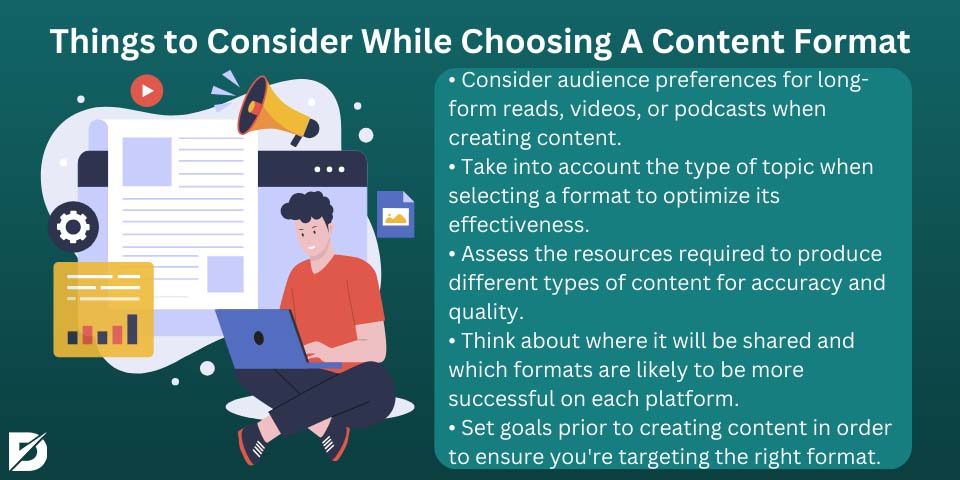
- Audience Preference: Does your target audience prefer long-form reads, or are they more inclined to watch videos or listen to podcasts?
- Topic Suitability: Some topics lend themselves better to certain formats. For instance, a step-by-step tutorial might be better as a video, while an industry trend analysis might fit a blog post.
- Resource Availability: Producing a high-quality video requires different resources than writing a blog post or designing an infographic.
- Distribution Channels: Where will you share the content? If your audience primarily uses LinkedIn, then long-form posts or SlideShare presentations might be more effective than, say, infographics.
- Goals: If brand visibility is your aim, then highly shareable content like infographics or interactive content might be beneficial. For lead generation, e-books or webinars might be more appropriate.
In conclusion, while jumping on every format is tempting, focusing on those that align best with your brand, audience, and objectives is essential. Test different formats, analyze performance, and refine your approach based on feedback and results.
Writing High-Quality Content
Writing high-quality content is foundational to any effective content marketing strategy. Quality content can help build brand authority, engage readers, improve SEO rankings, and convert visitors into loyal customers. Here’s how to ensure you’re producing high-caliber content:
- Understand Your Audience: Know who you’re writing for before you start writing. Understand their interests, needs, challenges, and preferences. Create buyer personas to guide your content creation process.
- Define Your Purpose: Each piece of content should have a clear objective. Are you aiming to inform, entertain, persuade, or solve a specific problem? Knowing your purpose ensures your content stays focused and relevant.
- Research Thoroughly: Use reputable sources and always fact-check. Dive deep into the topic to offer unique insights or a fresh perspective.
- Structure Your Content: Use clear headings and subheadings to make your content scannable. Break up long paragraphs, and use bullet points or numbered lists where appropriate.
- Engaging Introduction: Hook your readers from the start. A compelling introduction sets the tone and encourages readers to continue.
- Use a Conversational Tone: A conversational tone makes your content more relatable and engaging unless you’re writing for a very formal audience.
- Include Visuals: Images, infographics, videos, or charts can break up text, illustrate points, and improve engagement.
- Optimize for SEO:
- Integrate relevant keywords naturally.
- Use meta titles and descriptions.
- Ensure a mobile-friendly layout.
- Utilize internal and external linking strategies.
- Proofread and Edit: Even minor errors can undermine your credibility. Always proofread, use tools like Grammarly or Hemingway Editor, and consider having a colleague review your content.
- Include a Call-to-Action (CTA): Guide your readers on what to do next, whether reading another article, signing up for a newsletter, or making a purchase.
- Be Authentic: Authenticity builds trust. Share personal experiences, admit when you don’t know something, and avoid unnecessary jargon.
- Stay Updated: Industries evolve, and what’s accurate today might not be in the future. Periodically review and update your content to keep it relevant.
- Encourage Engagement: End with a question or a prompt to encourage comments and discussions. Engage with readers who comment on or share your content.
- Avoid Plagiarism: Always give credit where it’s due. If you reference or quote another source, attribute it properly. Use tools like Copyscape or Turnitin to ensure originality.
Remember, quality often trumps quantity in content marketing. It’s better to produce one well-researched, well-written piece of content than several mediocre ones. Consistently delivering high-quality content will position you as an authority in your field and help foster trust with your audience.
Optimizing Content for SEO
Optimizing content for SEO (Search Engine Optimization) is vital to ensure your content ranks well on search engines, primarily Google. It can significantly increase your content’s visibility, drive organic traffic to your website, and boost engagement. Here’s a step-by-step guide to optimizing your content for SEO:
- Keyword Research: Before composing, identify your material’s pertinent keywords. Utilize platforms such as Google Keyword Planner, Ahrefs, or SEMrush to discover keywords that strike an optimal balance between search volume and competitiveness.
- Integrate Keywords Naturally:
- Title: Ensure your primary keyword is in the content title.
- Meta Description: This is a summary of your content that appears in search results. Incorporate your main keyword here.
- URL: A clean, concise URL with the keyword is ideal.
- Content: Integrate primary and secondary keywords naturally throughout the content. Avoid keyword stuffing.
- Use Header Tags: Properly structure your content with H1, H2, and H3 tags. These help search engines understand the hierarchy of your content.
- Optimize Images:
- File Names: Name your image files descriptively and in plain language.
- Alt Text: Concisely describe the image, integrating keywords where appropriate.
- Compression: Use tools like TinyPNG to compress images, ensuring faster loading times.
- Internal Linking and External Linking:
- Internal Links: Link to other relevant articles or pages on your website. This helps with site navigation and establishes a site hierarchy.
- External Links: Link to authoritative external sources to improve credibility. Ensure these links are set to open in a new tab.
- Optimize for Mobile: With a significant portion of users accessing content via mobile, ensure your content is mobile-friendly. Google’s Mobile-Friendly Test and Dopinger’s Mobile-Friendly Test Tool can be helpful tools.
- Ensure High-Quality Content: Search engines prioritize content that provides value. Well-researched, well-written, and unique content is more likely to rank higher.
- Use Schema Markup: This type of microdata added to the website creates an enhanced description (often called a rich snippet) that appears in search results.
- Optimize Page Speed: Slow-loading pages can negatively affect your SEO ranking. Use tools like Google PageSpeed Insights to analyze and improve page load times. Also, you can use Dopinger’s Website Speed Test tool.
- Engage Readers: Encourage comments, shares, and interactions. Search engines see this engagement as an indication of quality content.
- Regularly Update Content: Outdated content can drop in search rankings. Periodically review and update your content to keep it current and relevant.
- Consider User Experience: Navigation, design, and readability all play a role in SEO. A positive user experience can reduce bounce rates and increase dwell time, which can influence search rankings.
- Avoid Duplicate Content: Search engines can penalize sites for duplicate content. Ensure each piece of content on your site is unique.
- Implement an SSL Certificate: Sites with “HTTPS” are seen as more secure and can have a slight SEO advantage over “HTTP” sites.
Remember that SEO is a long game. It may take time to see significant results, and the landscape is always evolving. Keep abreast of the most recent SEO developments and best practices, and be ready to adapt your approach as search engine algorithms evolve.
Why Is Content Marketing Important?
Content marketing is a deliberate strategy centered on producing, sharing, and endorsing meaningful, pertinent, and steady material to captivate and maintain a targeted audience. Here’s why it’s such a crucial component of modern marketing:
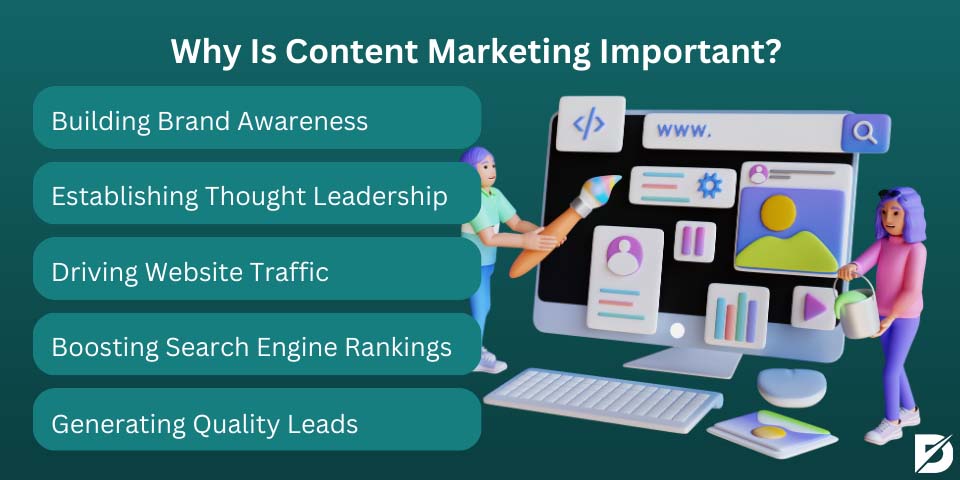
Building Brand Awareness
- Reach a Wider Audience: By producing content that’s shared on social media, recommended by others, or featured on external platforms, you can expose your brand to individuals who might not have found you otherwise.
- Showcase Brand Personality: Content allows you to express your brand’s voice, values, and personality, helping to differentiate you from competitors.
- Build Brand Recall: Consistently delivering valuable content ensures your brand stays top-of-mind for potential customers when they’re ready to make purchasing decisions.
Establishing Thought Leadership
- Demonstrate Expertise: Sharing knowledgeable content on industry trends, insights, and innovations positions your brand as an authority in your field.
- Build Trust: Consumers are more likely to trust brands that provide unbiased, educational, and actionable content.
- Influence Decisions: As a thought leader, your perspectives can shape industry conversations and consumer decision-making processes.
Driving Website Traffic
- Consistent Flow of Visitors: Regularly updated content gives audiences a reason to keep returning to your site.
- Engage Longer: Quality content can increase the time users spend on your website, providing more opportunities to convert them into customers.
- Diversify Traffic Sources: By producing a range of content types (blogs, videos, infographics), you can attract diverse audience segments.
Boosting Search Engine Rankings
- Organic Visibility: Search engines reward high-quality, relevant content with higher rankings, ensuring your brand is visible when potential customers search for related terms.
- Backlink Opportunities: Exceptional content can earn backlinks from reputable sources, further boosting SEO efforts.
- Enhance User Experience: SEO isn’t just about keywords. An optimized site structure, mobile compatibility, and fast load times—all components of content marketing—positively impact rankings. You can improve SEO with user experience factors.
Generating Quality Leads
- Targeted Content for Segmented Audiences: Content tailored to specific audience segments or stages of the buyer’s journey can attract high-quality leads.
- Educate Potential Customers: Before making a purchase, consumers often seek information. Providing this through content can nurture them down the sales funnel.
- Lead Magnets: Offering valuable content in exchange for contact details (e.g., eBooks, whitepapers) is an effective lead generation strategy.
In conclusion, content marketing plays a pivotal role in modern digital strategies, touching everything from brand perception and authority to SEO and lead generation. By offering value first and fostering genuine connections with audiences, businesses can achieve sustainable growth and longevity in a competitive market landscape.
How to Create a Content Marketing Strategy
Creating a content marketing strategy is essential for guiding your efforts and ensuring they align with your business objectives. A well-crafted strategy helps streamline content creation, distribution, and analysis, allowing for a cohesive approach to engage and nurture your target audience.
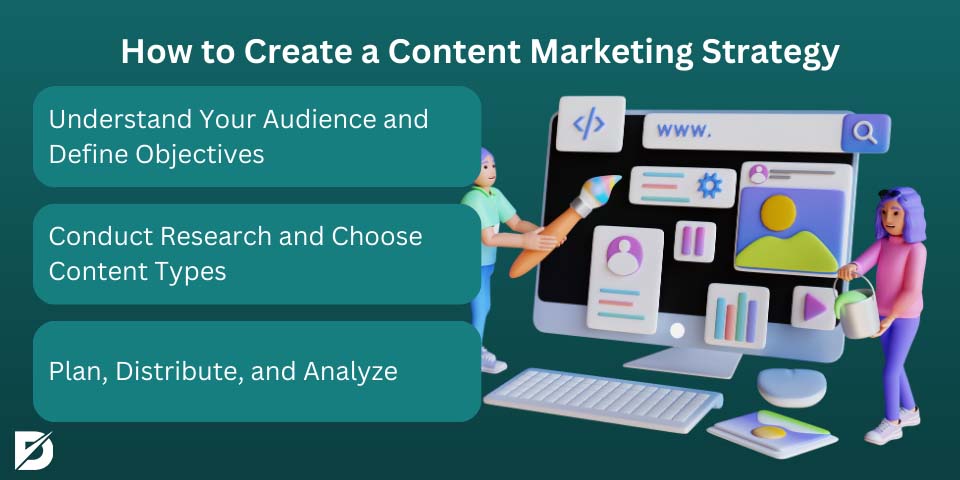
Understand Your Audience and Define Objectives
Begin by defining your target audience and understanding their needs, preferences, and pain points. Create detailed buyer personas to represent different segments of your audience. These personas should include demographic data, online behavior, and personal challenges related to your product or service. Once you have a clear picture of who you’re targeting, set measurable goals for your content marketing efforts. Whether it’s increasing website traffic, boosting brand awareness, generating leads, or driving sales, having clear objectives helps tailor your content to achieve the desired outcomes.
Conduct Research and Choose Content Types
Research is the cornerstone of an effective content marketing strategy. Analyze what your competitors are doing, identify content gaps in your industry, and discover trending topics using tools like Google Trends, BuzzSumo, or SEMrush. Based on your research and your audience’s preferences, decide on the types of content that would resonate most. This can include blog posts, videos, infographics, podcasts, webinars, and more. Additionally, consider the buyer’s journey — from awareness to consideration to decision — and create content tailored for each stage.
Plan, Distribute, and Analyze
With your research in hand, create a content calendar detailing what will be published, when, and on which platforms. This helps in maintaining consistency, which is key for audience engagement and SEO. Next, focus on distribution. Besides your own channels, consider leveraging email marketing, social media promotion, influencer partnerships, and paid advertising to maximize reach. Lastly, regularly analyze your content’s performance using tools like Google Analytics, social media insights, and email marketing reports. Assess metrics relevant to your objectives and adjust your strategy based on data-driven insights to continually refine and optimize your approach.
How Does Content Marketing Drive Sales?
Content marketing has emerged as a powerful driver for sales in the digital age, acting as the bridge between brand awareness and conversion. At its core, content marketing appeals to the modern consumer’s desire for knowledge, clarity, and authenticity before making a purchasing decision. As consumers are becoming more averse to traditional, interruptive advertising tactics, they’re gravitating towards brands that offer valuable insights and stories.
The sales process often begins long before a potential buyer reaches out to a sales representative or adds an item to their online cart. With the vast amount of information available online, consumers today prefer to conduct their research, compare products, and gather recommendations. Content marketing caters to this behavior by offering educational articles, in-depth product reviews, testimonials, video demonstrations, and more. This not only establishes trust by positioning the brand as an expert in its domain but also ensures that when the consumer is ready to purchase, the brand is top-of-mind. By nurturing potential leads with relevant content, businesses can subtly guide consumers through the sales funnel, addressing their concerns and answering their questions at every stage.
Moreover, content marketing offers unparalleled opportunities for personalization and targeting. By analyzing user behaviors, preferences, and interactions with content, businesses can craft highly targeted campaigns that resonate with specific audience segments. For instance, retargeting a website visitor with a tailored piece of content based on their browsing history can significantly increase conversion rates. Additionally, content marketing strategies often incorporate strong calls-to-action, exclusive offers, and incentives, further incentivizing the transition from a casual reader to a committed buyer. When executed with precision, content marketing becomes a sales-driving powerhouse, seamlessly merging the realms of information and commerce.
How to Measure Content Marketing
The success of a content marketing campaign should not be left to guesswork. By using specific metrics and analytical tools, businesses can gauge the efficacy of their content efforts and make informed decisions about strategy adjustments. Effective measurement revolves around understanding the objectives of your content and selecting the right metrics to assess performance in relation to those objectives.
Initially, it’s crucial to identify your Key Performance Indicators (KPIs). If your goal is brand awareness, metrics like page views, social shares, and time spent on the page become essential. If, however, you’re aiming for lead generation, then conversion rates, number of new subscribers, and lead quality should be your focus. Likewise, for boosting customer engagement, look at metrics such as comments, likes, shares, and repeat visits. Every piece of content, whether it’s a blog post, a video, or an infographic, should have clearly defined KPIs that align with larger business goals.
While quantitative data is invaluable, it’s essential not to overlook qualitative feedback. Comments on your posts, direct feedback, and discussions on social media platforms provide insights into how your audience perceives your content. Additionally, utilizing tools like Google Analytics, social media analytics platforms, and content performance platforms (e.g., HubSpot or Contently) can offer a comprehensive view of your content’s performance. Businesses can consistently track, analyze, and iterate based on these metrics and feedback to refine their content marketing strategies for maximum impact.
Effectiveness of Content Marketing
Content marketing stands as one of the most potent tools in the arsenal of modern marketers, and its effectiveness is evident across several dimensions. At its core, content marketing shifts the focus from a traditional advertising model, where brands intrusively push messages, to a more organic and pull-based approach, where brands attract audiences by offering genuine value.
Content marketing companies have witnessed a tremendous surge in demand in recent years. As businesses recognize the importance of storytelling and providing valuable information to their audiences, they turn to these companies to craft compelling narratives that align with their brand and values. These entities often collaborate closely with content marketing agencies, which offer specialized expertise in designing and implementing marketing campaigns tailored to specific industries and target audiences. A content marketing company might operate in tandem with an agency or independently, but both aim to provide clients with results-driven strategies to enhance their online presence.
One of the significant challenges many businesses face is identifying the best content marketing tools to streamline their efforts. From editorial calendars to analytics dashboards, these tools play an instrumental role in ensuring that the content marketing manager can efficiently plan, execute, and monitor campaigns. For those operating in the business-to-business domain, devising a B2B content marketing strategy becomes even more critical. This often entails collaborating with a content marketing consultant who can offer insights tailored to the B2B market nuances and suggest the right content marketing platform to reach the intended audience effectively.
Conclusion to Content Marketing Guide
With the vast array of types of content marketing available, from blogs and podcasts to infographics and webinars, it’s essential for businesses to stay updated with the latest content marketing tips. Content marketing can drastically improve a brand’s online visibility, engagement, and conversions. When done correctly, it not only attracts and retains customers but also establishes a company as a thought leader in its respective industry. The key lies in understanding the audience’s needs, staying updated with industry trends, and consistently delivering valuable content.
Frequently Asked Questions About
Content marketing is a strategic approach focused on creating, distributing, and promoting valuable, relevant, and consistent content to attract, engage, and retain a specific audience.
Traditional advertising involves direct promotions, pushing products or services to the audience. Conversely, content marketing involves providing useful and relevant content to attract and inform the audience, fostering deeper relationships, and building trust over time.
Content marketing can help businesses increase brand awareness, establish thought leadership, drive organic website traffic, improve search engine rankings, and generate quality leads.
The success of content marketing can be measured using various metrics, including website traffic, time spent on content, social media shares, lead generation, conversion rates, and ROI.
Content marketing encompasses a wide range of formats, including blog posts, videos, podcasts, infographics, ebooks, webinars, case studies, newsletters, whitepapers, and more.
The frequency of content publication depends on your industry, resources, and audience’s needs. The key is consistency and ensuring that the quality of the content remains high.

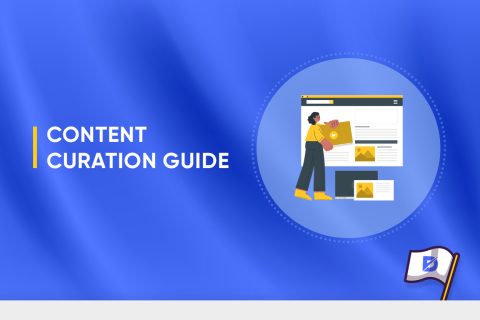


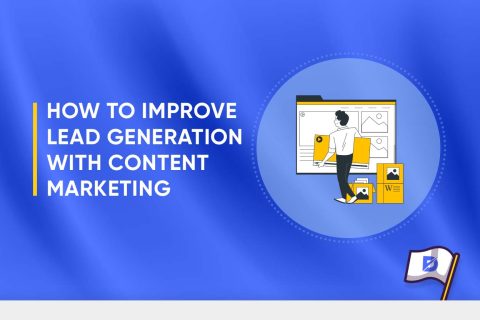
No comments to show.